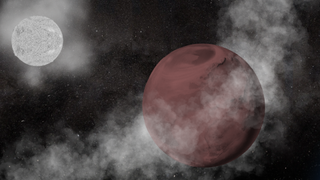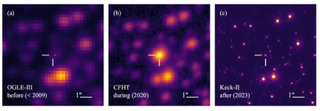This exoplanet circling a dead star may mirror Earth's fate — if our planet survives a dying sun, that is
"We do not currently have a consensus whether Earth could avoid being engulfed by the red giant sun in 6 billion years."

A planetary system anchored by a dead white dwarf star, located around 4,000 light-years away, has offered astronomers a possible glimpse into what our sun and Earth could look like in around 8 billion years.
However, this would only be Earth's future if our planet manages to survive the sun's eventual transformation into a swollen red giant. This transformation is expected to happen around 5 billion to 6 billion years from now, when the sun finally exhausts its fuel supply needed for nuclear fusion. That red giant phase will see the sun swell up to around the orbit of Mars, swallowing Mercury, Venus — and maybe Earth, too. After this, the sun would become a smoldering white dwarf, just like the one seen in the observed planetary system.
One way our planet could escape destruction by the red giant sun is if it migrates out to the orbit of Mars or beyond. This would leave our planet a radiation-blasted yet freezing husk orbiting a burned-out star. This new planetary system offers evidence that such a "miracle escape" is possible.
The team identified a white dwarf with around half the mass of the sun and an Earth-size companion planet in an orbit twice as wide as our planet's around our star, offering a picture of what a surviving Earth could look like in around 8 billion years.
Related: Did a star escape cannibalism by its dead 'monster' white dwarf companion?
"We do not currently have a consensus whether Earth could avoid being engulfed by the red giant sun in 6 billion years," team leader Keming Zhang, an Eric and Wendy Schmidt AI in Science Postdoctoral fellow at the University of California, San Diego, said in a statement.
One element of the system, located near the central bulge of the Milky Way galaxy, sets it apart from the future solar system: another occupant with a mass around 17 times that of Jupiter, the solar system's most massive planet.
Get the Space.com Newsletter
Breaking space news, the latest updates on rocket launches, skywatching events and more!
This object is likely to be a "brown dwarf," a body often referred to as a "failed star" because it forms like a star but fails to pile on the mass needed to trigger the fusion of hydrogen to helium in its core, the nuclear process that defines a "main sequence" star like the sun.
Good news for Earth... maybe not for life
Astronomers discovered this analog for the future of the solar system when they observed a so-called "microlensing event," referring to the curvature of light from a background source caused by the gravitational influence of a body passing between that source and Earth. The particular event was caught using the Korea Microlensing Telescope Network in the Southern Hemisphere.
Microlensing is a weak form of gravitational lensing, a phenomenon first predicted by Albert Einstein with his general relativity theory. General relativity suggests that objects with mass cause the very fabric of spacetime, a four-dimensional unification of space and time, to "warp." Not only does gravity arise from this warping, but the warps also bend light when waves from a background source passes through them. This bent light then appears brightened from our perspective because of the curved path it is forced to take on its way to our detectors.
This event, dubbed KMT-2020-BLG-0414, was observed in 2020. It consisted of the brightening of a background star (located 24,000 light-years away) by around 1,000 times. The objects or lenses causing this brightening are the bodies of the planetary system.
To investigate this planetary system further, the University of California, Berkeley, team followed up the microlensing event with the Keck 10-meter telescopes in Hawaii.

The initial investigation didn't reveal the nature of the central star. It took the researchers another three years of study using the Keck telescopes to determine that this stellar body is an exhausted white dwarf. This wasn't evident from what the team saw but rather from what they didn't see; images of the system failed to show the light that would be expected from a main sequence star.
"Our conclusions are based on ruling out the alternative scenarios since a normal star would have been easily seen," Zhang explained. "Because the lens is both dark and low mass, we concluded that it can only be a white dwarf. There is some luck involved because you'd expect fewer than one in 10 microlensing stars with planets to be white dwarfs."
Continuing the investigation of this system also allowed the team to resolve the orbit of the brown dwarf and relieve confusion surrounding the failed star's position around the dead star, as well as the fact that it isn't simply a very close-in massive planet, or "hot Jupiter."
"The original analysis showed that the brown dwarf is either in a very wide orbit, like Neptune's, or well within Mercury's orbit [the closest planet to the sun in the solar system]," Zhang said. "Giant planets on very small orbits are actually quite common outside the solar system. But since we now know it is orbiting a stellar remnant, this is unlikely, as it would have been engulfed."

While this planetary system serves as evidence that Earth could escape consumption by the sun in around 6 billion years, it doesn't tell us if any life on our planet (if it still exists by then) could also survive.
"Whether life can survive on Earth through that [red giant] period is unknown. But certainly, the most important thing is that Earth isn't swallowed by the sun when it becomes a red giant," Jessica Lu, associate professor and chair of astronomy at UC Berkeley, said in the statement. "This system is an example of a planet — probably an Earth-like planet originally on a similar orbit to Earth — that survived its host star's red giant phase."
It does seem that, if the loss of the sun's grip on Earth during the red giant phase allows it to escape our star's swelling outer layers, this migration would also put it outside the habitable zone. The habitable zone, or "Goldilocks zone," is defined as the region around a star with temperatures neither too hot nor too cold to allow a planet to hang onto liquid water, a crucial ingredient for life.
However, humanity's time on Earth is likely to have run out around 4 billion to 5 billion years before the sun goes red giant.
"In any case, planet Earth will only be habitable for around another billion years, at which point Earth's oceans would be vaporized by runaway greenhouse effect — long before the risk of getting swallowed by the red giant," Zhang said.
Zhang suggested that humanity could migrate outward into the solar system to avoid this fate. Potential targets for resettlement could be the moons of Jupiter, such as Europa, Callisto, and Ganymede, or Enceladus, which orbits Saturn. These moons appear to have frozen water oceans that, though icy now, could ironically be made habitable by the expanding sun. That's because the sun could potentially thaw them, making them ocean worlds.
"As the sun becomes a red giant, the habitable zone will move to around Jupiter and Saturn's orbit," Zhang said. "I think, in that case, humanity could migrate out there."
The team suggests that this research demonstrates the potential of microlensing as a technique to investigate planetary systems and their stars. One instrument that could fully take advantage of this is the forthcoming Nancy Grace Roman Telescope, scheduled for launch in 2027. NASA's next major space telescope will use microlensing to hunt for extrasolar planets or "exoplanets."
"There is a whole set of worlds that are now opening up to us through the microlensing channel, and what's exciting is that we're on the precipice of finding exotic configurations like this," team member and UC Berkeley astronomer Joshua Bloom said in the statement. "What is required is careful follow-up with the world's best facilities not just a day or a month later, but many, many years into the future, after the lens has moved away from the background star so you can start disambiguating what you're seeing."
The research was published Sept. 26 in the journal Nature Astronomy.
Join our Space Forums to keep talking space on the latest missions, night sky and more! And if you have a news tip, correction or comment, let us know at: community@space.com.

Robert Lea is a science journalist in the U.K. whose articles have been published in Physics World, New Scientist, Astronomy Magazine, All About Space, Newsweek and ZME Science. He also writes about science communication for Elsevier and the European Journal of Physics. Rob holds a bachelor of science degree in physics and astronomy from the U.K.’s Open University. Follow him on Twitter @sciencef1rst.